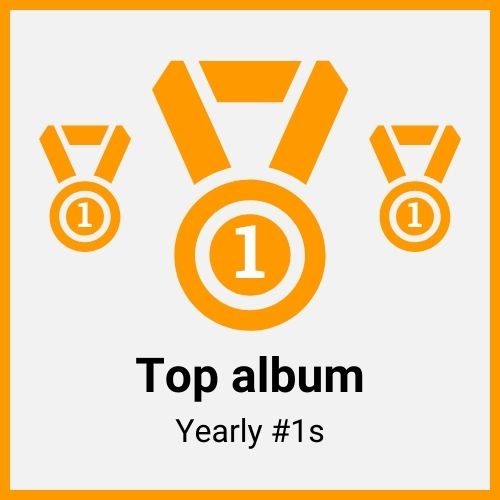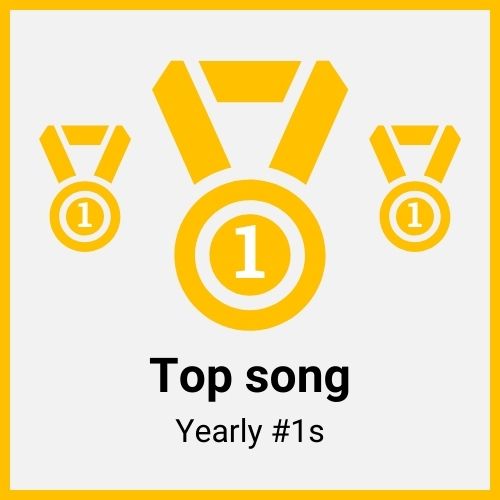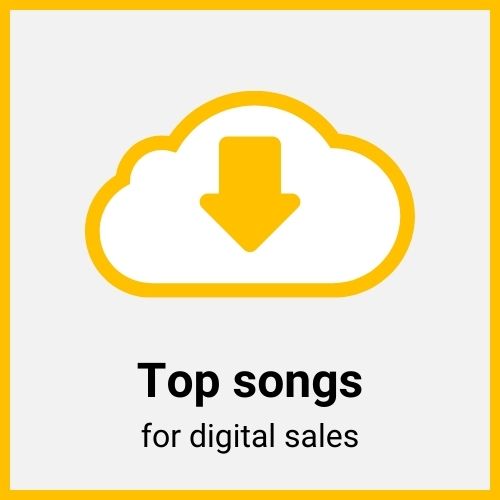Bob Marley albums and songs sales
In a time when everyone achieving 15 minutes of fame is labelled a legend, we may wonder which word would fit someone with Bob Marley‘s stature. The utterly iconic Reggae singer crossed over cultures, boundaries and generations to become way more than a simple singer. He is one of the World’s main flagships of love, peace and respect. More than 36 years after his death Marley‘s face remains widely known in every corner of the globe.
The symbolism of his persona reached such heights that he is more often compared to Gandhi, Ernesto Guevara, Nelson Mandela and Mother Teresa rather than Elvis Presley, Phil Collins, Elton John and Rod Stewart. The first four icons never sold a record. It raises a real question: while there is no doubt about his immense popularity beyond the music scene, has Marley really been as popular as a singer?
His records which include Exodus and Kaya are never mentioned among the best selling albums ever. If you add together his #1 hits in the US, the UK, France, Germany, Japan, the Netherlands, Australia, Sweden, Austria, Switzerland, Norway, Finland and Belgium, you get the total of zero. I mention #1 hits, in reality Marley‘s songs never made the US Hot 100 top 50. Maybe he was an album seller instead? In the UK and Germany, his studio outputs never made the Top 3. In the US, Rastaman Vibration was his only Top 10 LP by going to #8.
Songs like No Woman No Cry, Could You Be Loved, Three Little Birds or Is This Love? seem widely popular though. Where is the truth then? How popular really is Marley and his catalog? Which songs are the most remembered to this day? How do his albums perform against their contemporary competitors?
ChartMasters’ method: the CSPC
As usual, I’ll be using the Commensurate Sales to Popularity Concept (CSPC) in order to relevantly gauge the act’s results. It will not only bring you sales information for all albums, physical and download singles, as well as audio and video streaming. In fact, it will really determine the act’s popularity.
If you are not yet familiar with the CSPC method, below is a nice and short video of explaining the concept. I recommend watching it before reading on and to the sales figures. You’ll get the idea in just two minutes.
And if you want to know the full method as well as formulas, you can read the full introduction article.
Now let’s get into the artist’s detailed sales figures!
Bob Marley’s original albums sales
Catch a Fire (1973)
- America
- US – 700,000
- Canada – 100,000
- Argentina – N/A
- Brazil – N/A
- Mexico – N/A
- Asia – N/A
- Japan – N/A
- Oceania
- Australia – 75,000
- New Zealand – 30,000
- Europe – 1,820,000
- UK – 200,000
- France – 405,000
- Germany – 350,000
- Italy – 175,000
- Spain – N/A
- Sweden – N/A
- Netherland – N/A
- Switzerland – N/A
- Austria – N/A
- Finland – N/A
- World – 3,175,000
Burnin’ (1973)
- America
- US – 850,000
- Canada – 100,000
- Argentina – N/A
- Brazil – N/A
- Mexico – N/A
- Asia – N/A
- Japan – N/A
- Oceania
- Australia – 75,000
- New Zealand – 30,000
- Europe – 1,700,000
- UK – 180,000
- France – 320,000
- Germany – 350,000
- Italy – 195,000
- Spain – N/A
- Sweden – N/A
- Netherland – N/A
- Switzerland – N/A
- Austria – N/A
- Finland – N/A
- World – 3,200,000
Natty Dread (1974)

- America
- US – 1,075,000
- Canada – 125,000
- Argentina – N/A
- Brazil – N/A
- Mexico – N/A
- Asia – N/A
- Japan – N/A
- Oceania
- Australia – 100,000
- New Zealand – 35,000
- Europe – 1,780,000
- UK – 240,000
- France – 380,000
- Germany – 300,000
- Italy – 215,000
- Spain – N/A
- Sweden – N/A
- Netherland – N/A
- Switzerland – N/A
- Austria – N/A
- Finland – N/A
- World – 3,650,000
Rastaman Vibration (1976)
:format(jpeg):mode_rgb():quality(40)/discogs-images/R-813077-1169764599.jpeg.jpg)
- America
- US – 1,500,000
- Canada – 150,000
- Argentina – N/A
- Brazil – N/A
- Mexico – N/A
- Asia – N/A
- Japan – N/A
- Oceania
- Australia – 125,000
- New Zealand – 40,000
- Europe – 2,030,000
- UK – 210,000
- France – 485,000
- Germany – 325,000
- Italy – 240,000
- Spain – N/A
- Sweden – 50,000
- Netherland – 100,000
- Switzerland – N/A
- Austria – N/A
- Finland – N/A
- World – 4,525,000
Exodus (1977)

- America
- US – 2,300,000
- Canada – 250,000
- Argentina – N/A
- Brazil – N/A
- Mexico – N/A
- Asia – N/A
- Japan – N/A
- Oceania
- Australia – 150,000
- New Zealand – 75,000
- Europe – 4,120,000
- UK – 875,000
- France – 880,000
- Germany – 650,000
- Italy – 325,000
- Spain – N/A
- Sweden – 90,000
- Netherland – 160,000
- Switzerland – N/A
- Austria – 60,000
- Finland – N/A
- World – 8,025,000
Kaya (1978)
- America
- US – 1,200,000
- Canada – 150,000
- Argentina – N/A
- Brazil – N/A
- Mexico – N/A
- Asia – N/A
- Japan – N/A
- Oceania
- Australia – 175,000
- New Zealand – 60,000
- Europe – 3,380,000
- UK – 500,000
- France – 920,000
- Germany – 475,000
- Italy – 275,000
- Spain – N/A
- Sweden – 80,000
- Netherland – 120,000
- Switzerland – N/A
- Austria – N/A
- Finland – N/A
- World – 5,925,000
Survival (1979)
- America
- US – 850,000
- Canada – 125,000
- Argentina – N/A
- Brazil – N/A
- Mexico – N/A
- Asia – N/A
- Japan – N/A
- Oceania
- Australia – 125,000
- New Zealand – 45,000
- Europe – 2,720,000
- UK – 225,000
- France – 705,000
- Germany – 450,000
- Italy – 300,000
- Spain – 200,000
- Sweden – 50,000
- Netherland – 80,000
- Switzerland – N/A
- Austria – N/A
- Finland – N/A
- World – 4,600,000
Uprising (1980)
:format(jpeg):mode_rgb():quality(40)/discogs-images/R-509137-1125408182.jpg.jpg)
- America
- US – 1,400,000
- Canada – 150,000
- Argentina – N/A
- Brazil – N/A
- Mexico – N/A
- Asia – N/A
- Japan – N/A
- Oceania
- Australia – 100,000
- New Zealand – 75,000
- Europe – 4,230,000
- UK – 325,000
- France – 985,000
- Germany – 850,000
- Italy – 450,000
- Spain – 225,000
- Sweden – 110,000
- Netherland – 140,000
- Switzerland – N/A
- Austria – 80,000
- Finland – N/A
- World – 7,025,000
Confrontation (1983)

- America
- US – 725,000
- Canada – 100,000
- Argentina – N/A
- Brazil – N/A
- Mexico – N/A
- Asia – N/A
- Japan – N/A
- Oceania
- Australia – 75,000
- New Zealand – 35,000
- Europe – 1,570,000
- UK – 180,000
- France – 450,000
- Germany – 200,000
- Italy – 15,000
- Spain – N/A
- Sweden – 40,000
- Netherland – 50,000
- Switzerland – N/A
- Austria – 20,000
- Finland – N/A
- World – 2,950,000
Original Album Sales – Comments
1973 Catch A Fire – 3,175,000
1973 Burnin’ – 3,200,000
1974 Natty Dread – 3,650,000
1976 Rastaman Vibration – 4,525,000
1977 Exodus– 8,025,000
1978 Kaya – 5,925,000
1979 Survival – 4,600,000
1980 Uprising – 7,025,000
1983 Confrontation – 2,950,000
The discography of Marley has two parts to it. The first one is made up of his recordings from the early 60s to 1972, while the second covers the period of 1973 to 1980 which is listed here. Those timeframes are fundamentally different in several ways.
In terms of format, the 1963-1972 period is exclusively made up of singles released at a fast pace. From 1973 on, Bob Marley and his teammates from the Wailers issued complete albums, starting with Catch A Fire.
In terms of music style, Marley was fully involved into Jamaica’s music evolution. He has gone from Ska tunes to Rocksteady songs to Reggae music during the first half of his career, while merging elements from Rock to his Reggae sound starting in 1973.
And in terms of business, he went from independent records / local label contracts to international releases thanks to his signing at Island Records, again in 1973.
This lack of proper studio albums pre-1973 explains why only later albums are listed here. The early songs shouldn’t be overlooked though. Various of them were newly recorded for those later albums like Stir It Up, Duppy Conqueror and Lively Up Yourself. As the early recordings are free of rights, they have been issued under hundreds and hundreds of compilations after the global breakthrough of Marley. We will get there during the upcoming section related to compilation albums.
Back to original album sales, we can notice that each of his 8 international studio albums plus the posthumous release Confrontation sold from 3 to 8 million units a piece. Those figures are incredible if we consider the non-existence of reggae when he started, the relatively low peaks of his albums and the mere 14,000 units sold by Catch A Fire during its promotional campaign. Those figures are rather low if we put them in front of Marley‘s aura.
No matter how we look at it, more than 43 million album sales on the back of his studio albums alone is truly merit-worthy.
Physical Singles Sales
As a reminder, the weighting is done with a 10 to 3 ratio between one album and one physical single.
1973-74
Marley first entered the UK Singles Chart in November 1975 when No Woman, No Cry debuted at #40, peaking at #22 one month later. That’s basically the only country where he made the charts. This shows that Marley‘s popularity was getting built by then with most of his singles going unnoticed. His biggest achievements by then were undoubtedly as a writer since Eric Clapton‘s cover of I Shot the Sheriff went to #1 in the US in September 1974.
His growing profile in later years plus the timeless appeal of his songs enabled Marley to increase his tally of physical singles sales thanks to various reissues. After his passing, No Woman, No Cry improved its original peak when it reached #8 in the UK. It was also reissued in 2005 to bring its final total to more than half a million sales, some 5 times more than after its original run. Pretty much every song from this page has been issued multiple times in distinct years.
Catch a Fire (1973) – 78,000 equivalent albums
Stir It Up – 170,000
Concrete Jungle – 80,000
Kinky Reggae – 10,000
Burnin’ (1973) – 93,000 equivalent albums
(I’m Gonna) Put It On – 30,000
Small Axe – 30,000
Duppy Conqueror – 60,000
Get Up, Stand Up – 110,000
I Shot The Sheriff – 80,000
Natty Dread (1974) – 198,000 equivalent albums
Lively Up Yourself – 80,000
So Jah Seh – 30,000
No Woman, No Cry – 550,000
1976-78
Roots, Rock, Reggae remains the only song from the singer that ever made the Billboard Hot 100 chart in the US. It peaked at a modest #51 position, although that was enough to push the Rastaman Vibration album to #8.
Songs from the album Exodus are the striking example of the incremental exploitation of Marley‘s catalog. In the UK, which was by far his main market for singles, three of its tracks were released as singles to solid success. The title track went to #14, Waiting In Vain to #27 and Jamming to #9 over a span of 7 months, a fairly standard promotional campaign for a hit album. It wasn’t over yet though.
The continuous increase of his popularity, culminated by Could You Be Loved in 1980, led Island Records to release Three Little Birds as a single in late 1980. The song did well by peaking at #17. Failing to chart in 1982 was the release of Natural Mystic. The medley One Love / People Get Ready dropped in 1984 to promote the best of Legend, hitting #5. Quickly, Waiting In Vain got a new run with a #31 peak. Three Little Birds was then re-run too going to #76 in 1985. Many years later, in 1992, Why Should I / Exodus was out to promote the Songs of Freedom box set, the single went to #42. Turn Your Lights Down Low charted at #15 when it was sampled featuring Lauryn Hill in 1999 to support the remix album Chant Down Babylon while Jammin’ followed in its footsteps in 2000 to less success as the song stopped at #42.
In total, the album Exodus has been home to 11 singles-eras over the course of 4 distinct decades thanks to which 6 of its songs are now over a quarter of a million physical singles sales.
On a lower scale the album Kaya also enjoyed the various re-runs of old songs. While both Is This Love? and Satisfy My Soul did well upon release, Sun Is Shining was a #3 hit in 1999. A new remix of Is This Love? also managed to go to #16 as recently as in 2016, but we will see that inside the section related to digital sales…
Rastaman Vibration (1976) – 93,000 equivalent albums
Johnny Was – 30,000
Roots, Rock, Reggae – 250,000
Positive Vibration – 30,000
Exodus (1977) – 741,000 equivalent albums
Exodus – 420,000
Waiting In Vain – 270,000
Jamming – 430,000
One Love / People Get Ready – 510,000
Three Little Birds – 320,000
Natural Mystic – 30,000
Why Should I/Exodus – 60,000
Turn Your Light Down Slow – 430,000
Kaya (1978) – 381,000 equivalent albums
Is This Love – 500,000
Satisfy My Soul – 160,000
Sun Is Shining – 610,000
1979-83 and orphan songs
Considering both Exodus and Kaya had Top 10 hits during their initial promotional campaign, we can consider that songs from Survival somewhat of a flop as only So Much Trouble in this World charted in the UK with a very modest #56 position.
Marley‘s hey-days weren’t done through as he quickly returned to success thanks to Could You Be Loved. The song reached the Top 10 in most of Europe, inclusively peaking at #5 for two weeks in the UK.
Sadly, the news of his cancer was soon revealed and his massively successful tour to support Uprising was interrupted less than 5 years after the initial entry of No Woman, No Cry inside charts. He passed away a few months later on May, 11, 1981.
He left behind a catalog full of priceless gems. One of them was Buffalo Soldier which became a global hit in 1983. Another one was the controversial Iron Lion Zion which validates the Rastas’ religion / movement views which consider the former dictator of Ethiopia Haile Selassie I as the incarnation of God. The song was still very successful peaking at #5 in the UK and #3 in France.
Please note that the remaining singles option of the Orphan category is especially big at 1,63 million due to the hundreds of singles released pre-1973 in Caribbean countries, plus in the UK and the US for the most successful of them like Mellow Mood and Soul Shakedown Party.
Survival (1979) – 93,000 equivalent albums
So Much Trouble In The World – 110,000
Wake Up And Live / Survival – 80,000
Zimbabwe – 80,000
One Drop – 30,000
Africa Unite – 10,000
Uprising (1980) – 336,000 equivalent albums
Could You Be Loved – 1,030,000
Redemption Song – 90,000
Confrontation (1983) – 168,000 equivalent albums
I Know – 20,000
Trench Town – 20,000
Buffalo Soldier – 520,000
Orphan singles – 813,000 equivalent albums
Simmer Down – 80,000
Reggae On Broadway – 80,000
Iron Lion Zion – 630,000
Keep On Moving – 140,000
Rainbow Country – 150,000
Remaining Singles – 1,630,000
Digital singles sales
As a reminder, the weighting is done with a 10 to 1,5 ratio between one album and one digital single.
1973-74
Stir It Up was released locally in 1967 and then internationally in 1973 to almost no success. In-between Johnny Nash made the song popular with his 1972 cover that reached #12 in the US and #13 in the UK. This popularity is visible with its digital sales which are now up to 1,55 million units.
In terms of US sales both Get Up, Stand Up and I Shot The Sheriff, are similar to Stir It Up but songs from the album Burnin’ appear to be unavailable to download in most countries, which explains why they are still yet to cross the million mark.
Expectedly, the absolute classic No Woman, No Cry has solid sales all around the world. It sold over 1,5 million downloads in the US alone and almost as many overseas to bring its comprehensive total to a huge 3,2 million once the addition of ringtones are included..
It is rather impressive to notice that each of those 3 albums that went mostly unnoticed when first released contain at least one golden great that remains widely remembered to this very day.
Catch a Fire (1973) – 302,000 equivalent albums
Stir It Up – 1,550,000
Concrete Jungle – 210,000
Remaining tracks – 250,000
Burnin’ (1973) – 273,000 equivalent albums
Get Up, Stand Up – 680,000
I Shot The Sheriff – 940,000
Remaining tracks – 200,000
Natty Dread (1974) – 548,000 equivalent albums
Lively Up Yourself – 160,000
Revolution – 130,000
No Woman, No Cry – 3,210,000
Remaining tracks – 150,000
1976-78
Rastaman Vibration was Marley‘s first hit album. Ironically, it is the only one from his first albums that has no song which continues to be popular to this day. It contains four songs with moderate downloads but nothing noteworthy.
It was kind of a shocker when Time Magazine named Exodus the Album of the Century in 1999. Its 8 million sales make one think that it isn’t thanks to its commercial success. While Time Magazine considered way more elements than just sales, we are starting to understand that even with that point of view Exodus is bigger than what we think. As many as 3 of its songs are multi-million sellers in digital formats, led by Three Little Birds which is over 4 million. It tops One Love and Jamming which were initially more successful. Four more songs have notable sales too to make it 7, a real Thriller-like performance. Its songs sold collectively a stunning 11 million units.
Kaya is consistent too with 5 relevant singles among which the classic Is This Love? which stands at 3,2 million.
Rastaman Vibration (1976) – 98,000 equivalent albums
War – 140,000
Roots, Rock, Reggae – 170,000
Positive Vibration – 180,000
Crazy Baldhead – 110,000
Remaining tracks – 50,000
Exodus (1977) – 1,649,000 equivalent albums
Exodus – 580,000
Waiting In Vain – 1,030,000
Jamming – 2,160,000
One Love / People Get Ready – 2,120,000
Three Little Birds – 4,090,000
Natural Mystic – 290,000
Turn Your Light Down Slow – 620,000
Remaining tracks – 100,000
Kaya (1978) – 729,000 equivalent albums
Is This Love – 3,220,000
Satisfy My Soul – 660,000
Sun Is Shining – 220,000
Easy Skanking – 530,000
Kaya – 130,000
Remaining tracks – 100,000
1979-83 and orphan songs
Survival replicates exactly the pattern of Rastaman Vibration with no real hit but four moderately known songs.
Just like Exodus put him back on track instantly, Uprising did the same job. It contains two sizable classics. In fact, Could You Be Loved is past 2 million digital sales while Redemption Song is on 1,6 million. Three more songs have decent numbers.
Confrontation only has one popular track but what a song it is… Buffalo Solider. It’s close to 2,5 million units sold in digital formats.
With 9 studio albums the norm for most artists is to have 1 or 2 with big hits. The norm is reversed for Marley as he has only 2 albums fail to include at least one widely popular song. He sold nearly 34 million tracks in total, a tremendous achievement for an artist who passed away in 1981.
Survival (1979) – 116,000 equivalent albums
So Much Trouble In The World – 130,000
Ambush In the Night – 150,000
Zimbabwe – 190,000
Africa Unite – 150,000
Remaining tracks – 150,000
Uprising (1980) – 675,000 equivalent albums
Could You Be Loved – 2,220,000
Redemption Song – 1,580,000
Coming In From the Cold – 160,000
Pimper’s Paradise – 190,000
Forever Loving Jah – 150,000
Remaining tracks – 200,000
Confrontation (1983) – 395,000 equivalent albums
Buffalo Soldier – 2,480,000
Remaining tracks – 150,000
Orphan singles – 269,000 equivalent albums
Punky Reggae Party – 450,000
War – 170,000
Hold Ya Head – 220,000
Remaining Singles – 950,000
Streaming Sales
Streaming is made up of two families – audio and video. Our CSPC methodology now includes both to better reflect the real popularity of each track. The main source of data for each avenue is respectively Spotify and YouTube. As detailed in the Fixing Log article, Spotify represents 132 million of the 212 million users of streaming platforms, while YouTube is pretty much the only video platform generating some revenue for the industry. Below is the equivalence set on the aforementioned article:
Audio Stream – 1500 plays equal 1 album unit
Video Stream – 11,750 views equal 1 album unit
Equivalent Albums Sales (EAS) = 212/132 * Spotify streams / 1500 + YouTube views / 11750
1973-74
Mind-blowing. The strength of Marley‘s discography on streaming services is incredible. It starts with the album Catch a Fire which contains Stir It Up, now over 50 million streams on Spotify. Most of the tracks are at 5 million or more. The album has overall a solid 143,000 EAS from streams.
Burnin’ is even bigger thanks to I Shot the Sheriff and Get Up, Stand Up both well over 40 million streams on Spotify and 100 million views on YouTube. In total it is on 171,000 EAS.
Then comes Natty Dread which has great all-round figures on top of No Woman, No Cry‘s massive performances. This song has nearly 200 million comprehensive audio streams and over 350 million video streams. Natty Dread registers 237,000 EAS.
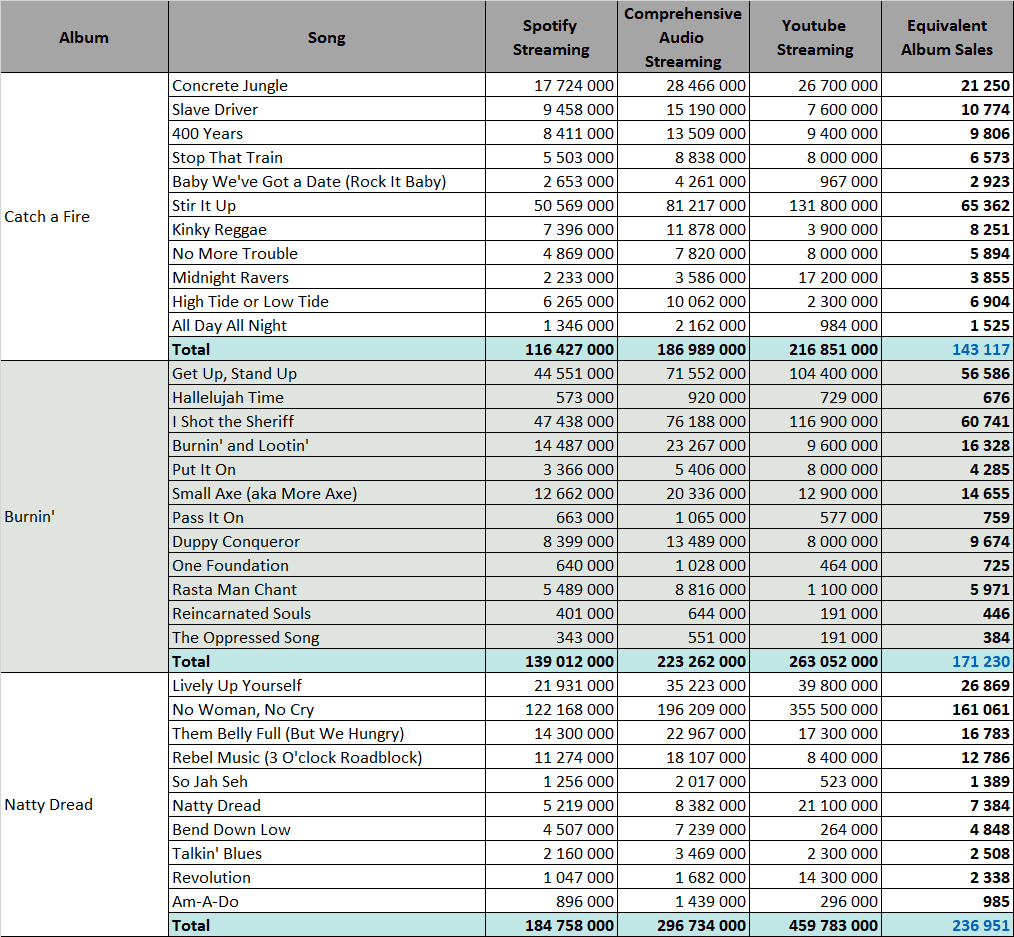
1976-78
Rastaman Vibration looks weak at a strong 89,000 EAS only because of the amazing results of all Marley‘s albums in streams. It still has 3 songs over 10 million on Spotify and its entire track list which tops easily 1 million.
Exodus continues to impress. On Spotify, Three Little Birds is getting closer to 200 million every day while both Jamming and One Love are over 100 million. Don’t get it wrong, those figures aren’t only good for a reggae artist. After checking hundreds and hundreds of albums from the top selling acts of all-time, this is only the 5th pre-2000 album which registers 3 songs over 100 million on Spotify. The remaining four albums are Michael Jackson‘s Thriller, Fleetwood Mac‘s Rumours, Guns N’ Roses‘ Appetite For Destruction and Nirvana‘s Nevermind. This list of utterly iconic albums which accompanies Exodus says it all about its immense popularity. It also has 4 more tracks that destroy the 20 million plateau. The overall total is a groundbreaking 695,000 EAS.
Is This Love enjoyed several recent successful remixes to boost its already amazing streams up to 283 million on Spotify and 302 million on YouTube. It is quite simply the second highest streaming hit from the 70s behind Queen‘s Bohemian Rhapsody. Four more songs are very healthy streaming songs too with more than 15 million plays on both Spotify and YouTube. Every album track is solid as well. These superb numbers add for 512,000 EAS.
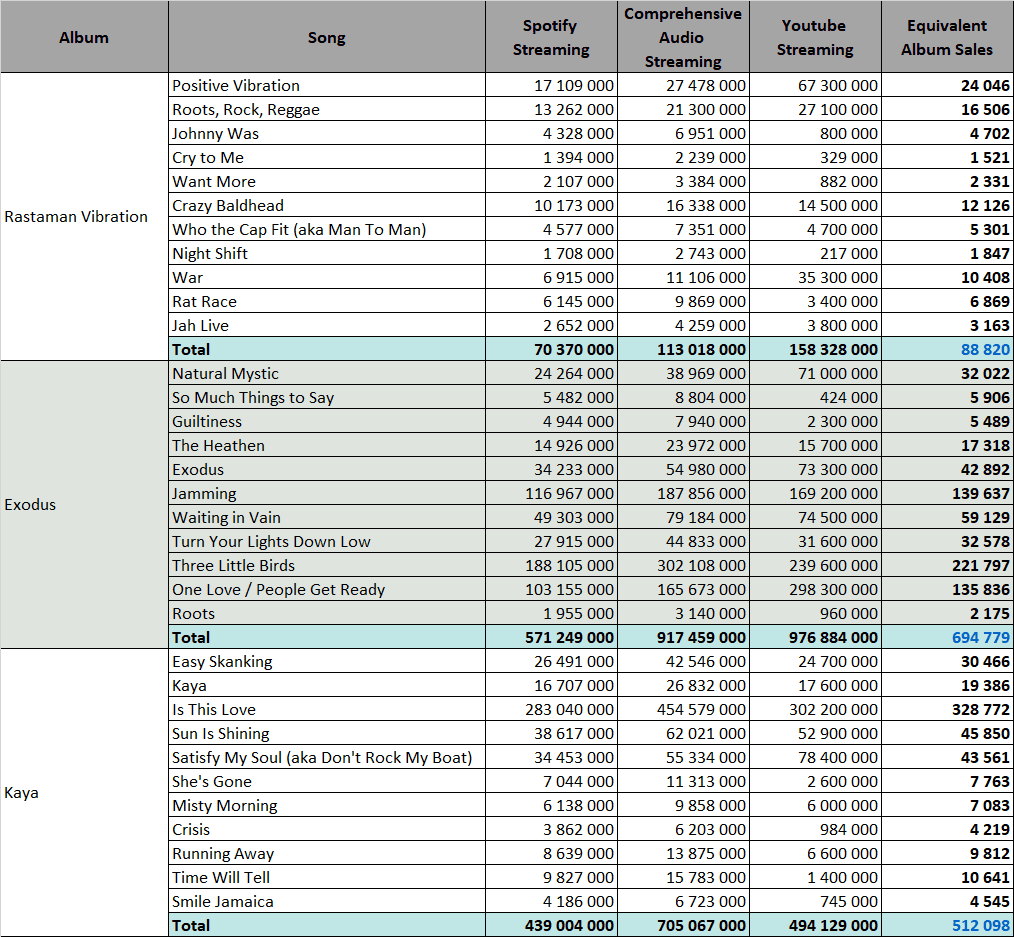
1979-83
Survival, arguably the weakest streaming album of Marley at 87,000 EAS, is still an absolutely superb performer. All its songs top 2 million streams on Spotify and 4 of them are now over 10 million.
There is no doubt that people aren’t only listening to a couple of Marley‘s songs, and they aren’t only playing the cult best of Legend either. People listen to his entire catalog. All songs from Uprising have more than 10 million streams combined. All his albums from 1975 to 1983 have all of their songs over 1 million on Spotify. This consistency is magnificent. It doesn’t prevent him from getting monster smashes also. Uprising adds two. Could You Be Loved and Redemption Song contributes into 297,000 EAS from the album’s total of 370,000.
The posthumous release Confrontation is boosted strongly by the classic Buffalo Soldier. The album has 179,000 EAS in total.
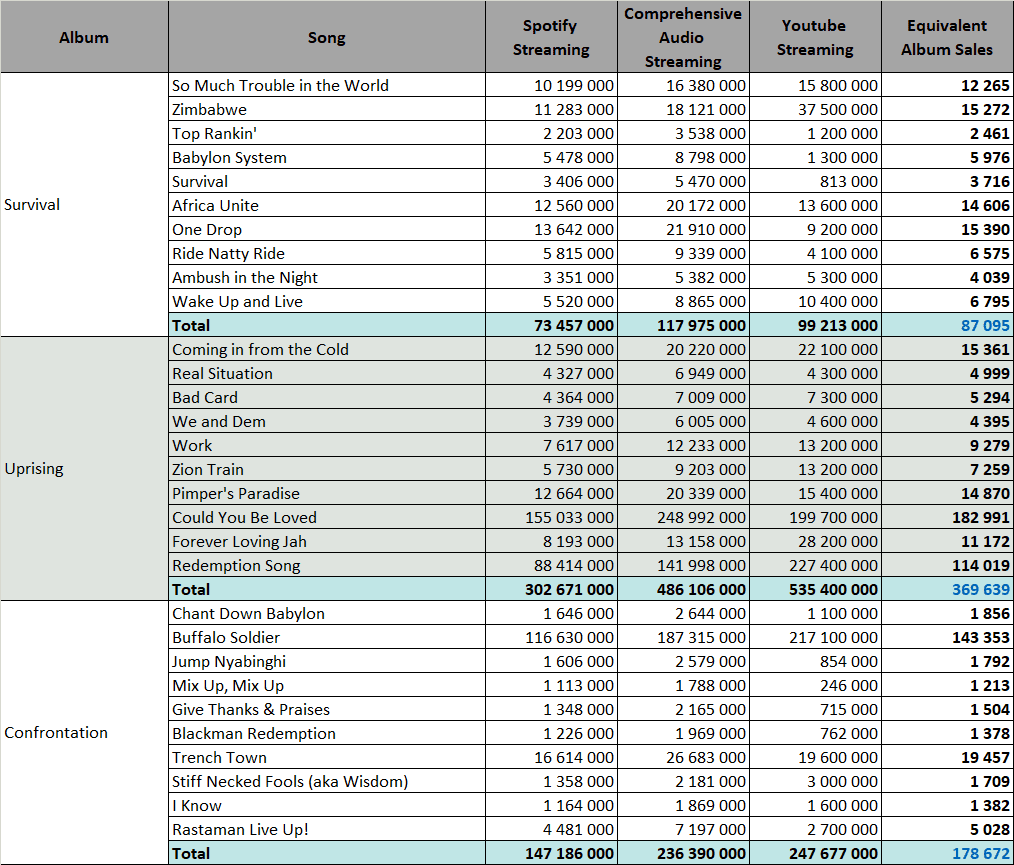
Orphan songs
The extensive discography of Marley before his international contract at Island becomes visible with an heavy list of orphan songs. None of them break 20 million Spotify streams but it still includes plenty of well known gems like Hold Ya Head, Iron Lion Zion, War / No More Trouble, Punky Reggae Party, Mr. Brown and Soul Rebel, with all of them over 10 million.
Those orphan songs amass a solid tally of 265,000 EAS.

Full Length related record Sales
It sounds fairly logical to add together weighted sales of one era – studio album, physical singles, downloads, streams – to get the full picture of an album’s popularity. For older releases though, they also generate sales of various live, music videos and compilation albums.
All those packaging-only records do not create value, they exploit the value originating from the parent studio album of each of its tracks instead. Inevitably, when such compilations are issued, this downgrades catalog sales of the original LP. Thus, to perfectly gauge the worth of these releases, we need to re-assign sales proportionally to its contribution of all the compilations which feature its songs. The following table explains this method.
Part 1 – Early Studio Albums
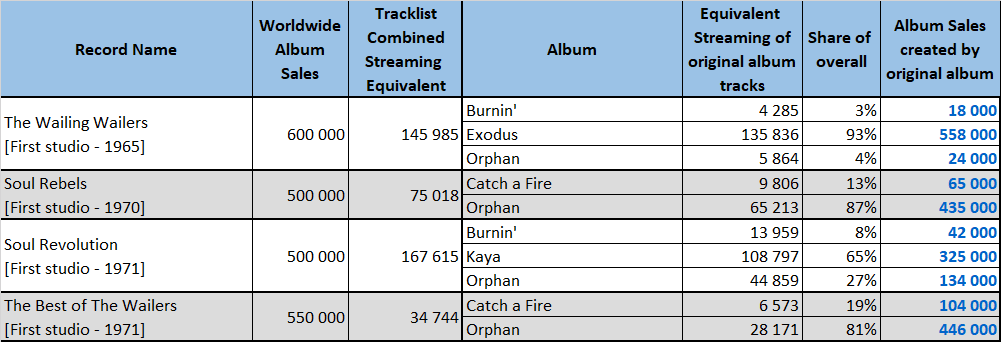
How to understand this table? If you check for example the The Wailing Wailers early album line, those figures mean it sold 600,000 units worldwide. The second statistics column means all versions of all the songs included on this package add for 146,000 equivalent album sales from streams of all types.
The second part on the right of the table shows how many equivalent streams are coming from each original album, plus the share it represents on the overall package. Thus, streaming figures tell us songs from the Burnin’ album are responsible for 3% of the The Wailing Wailers track list attractiveness. This means it generated 18,000 of its 600,000 album sales and so forth for the other records.
Those four albums are widely listed as the first four studio albums of Bob Marley & the Wailers. I decided to move them into the Orphan category as rather than studio albums recorded as such, those packages barely merged together hits previously issued as stand-alone singles. Some of them were later newly recorded and used to promote subsequent albums like Catch a Fire or Exodus. Since those later albums / versions of the songs are the popular ones which generated sales of the early records rather than the opposite, I considered that post-1973 LPs are the ones which created the value of those tunes.
Part 2 – Live albums
With more than 5 million sales each, Live! and Babylon by Bus have been incredibly successful live albums. The former of them is home to the most well known version of No Woman, No Cry. Naturally, the album which includes this song, Natty Dread, is the one which generated the largest share of Live! sales.
If both albums managed to continue selling well for decades it is because Babylon by Bus covers a completely different set of songs. The main providers of its appeal were hits from Exodus and Kaya, namely Jamming and Is This Love. This shows the incredible strength of a catalog when distinct pairs of songs can shoot live albums into 5 million plus sales.
Later live sets weren’t promoted the same way and were often hardly available after their original releases. It is still interesting to notice that they don’t follow the same distribution patterns among studio albums at all. Marley hasn’t been singing again and again the same hits with instead very diverse sets offered to the fans. The truly big release in terms of track list is Live Forever which includes nearly all the hits.
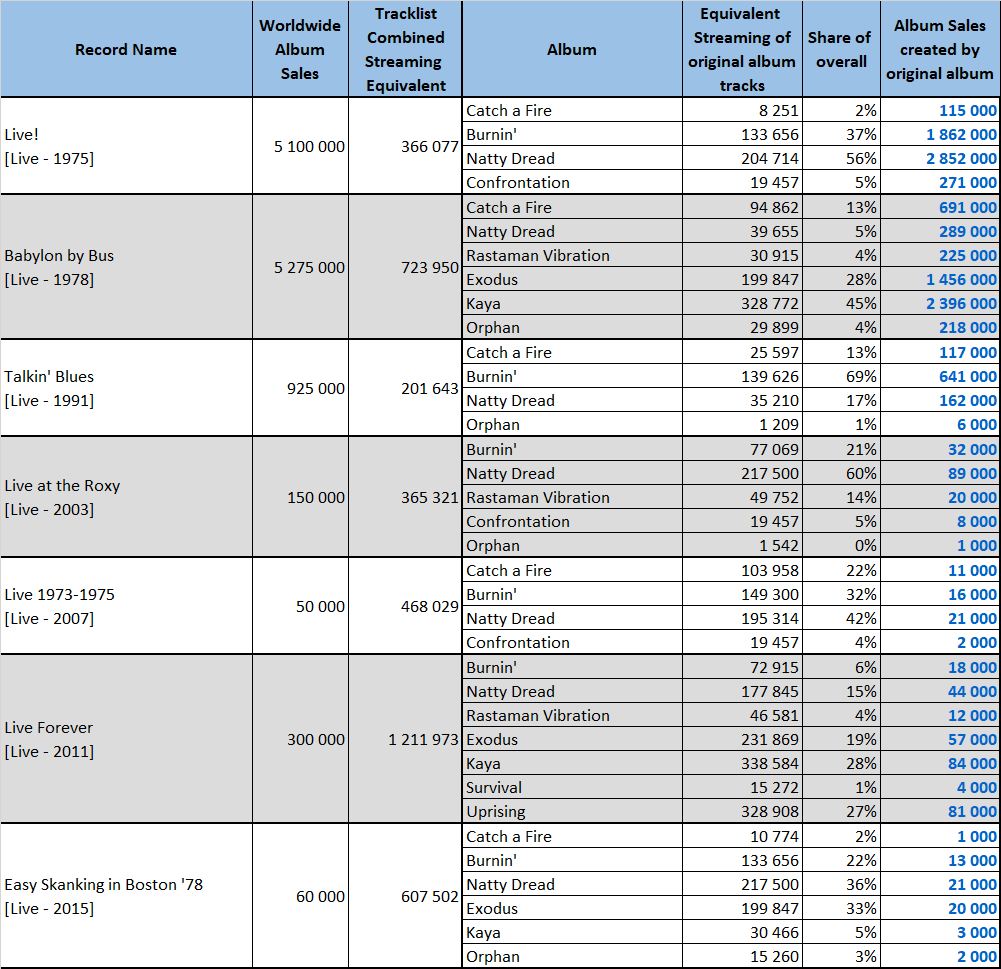
Part 3 – Island Records compilation albums
The track list of Legend is made up of barely 14 songs. Those songs are responsible for an unreal 1,8 million EAS. This represents an average of 193 million audio streams. Truly insane.
We better understand now the absolutely monstrous catalog sales of Legend. Easily the greatest selling catalog album since the early 90s ahead of Pink Floyd‘s Dark Side of the Moon, this LP went from peaking at #54 in the US to selling over 35 million units worldwide to date.
Getting a piece of such a blockbuster is tough. It’s so powerful that even a song like No Woman, No Cry can only claim 9% of its attractiveness. Exodus is the main driver of this juggernaut as it boasts 33% of its appeal, this represents a gigantic 11,7 million album sales.
Subsequent releases of career-spanning best of albums like One Love, Gold and Africa Unite never managed to dislodge Legend. They still sold a solid 5 million units combined with distribution patterns similar to the ones of Legend.
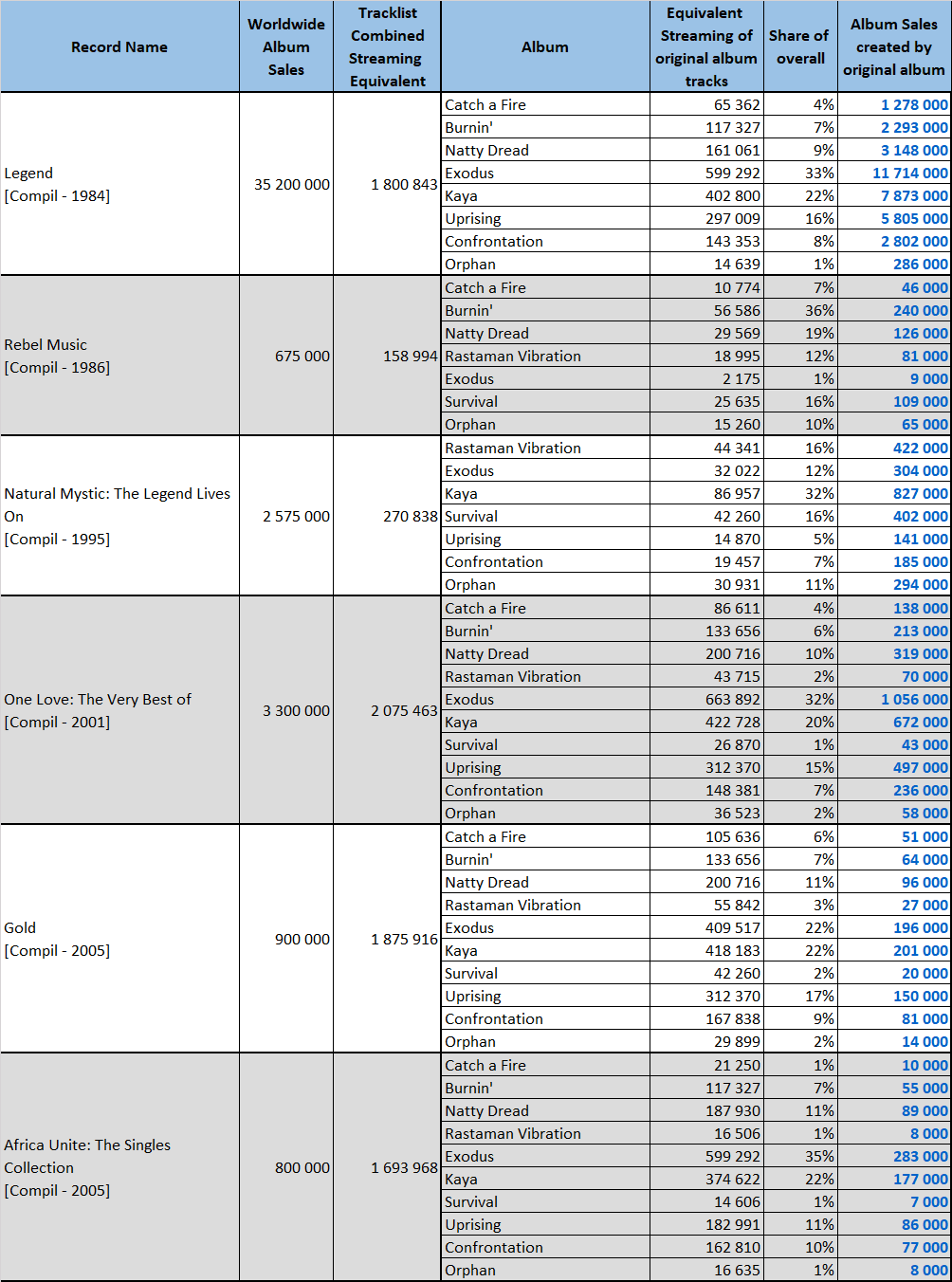
Part 4 – Island Records secondary compilation albums
Rebel Music and Natural Mystic are both extensions to Legend, which means they have no song in common. They are similar to releases like ABBA‘s More Gold or Queen‘s Greatest Hits 3. They sold very respectable amounts.
Songs Of Freedom includes all the biggest songs plus many more. This is one of the highest selling box sets ever at 1,7 million units. The Marley Soundtrack came out in 2012 along with the biopic to Marley‘s life. It is nothing else than one more compilation.
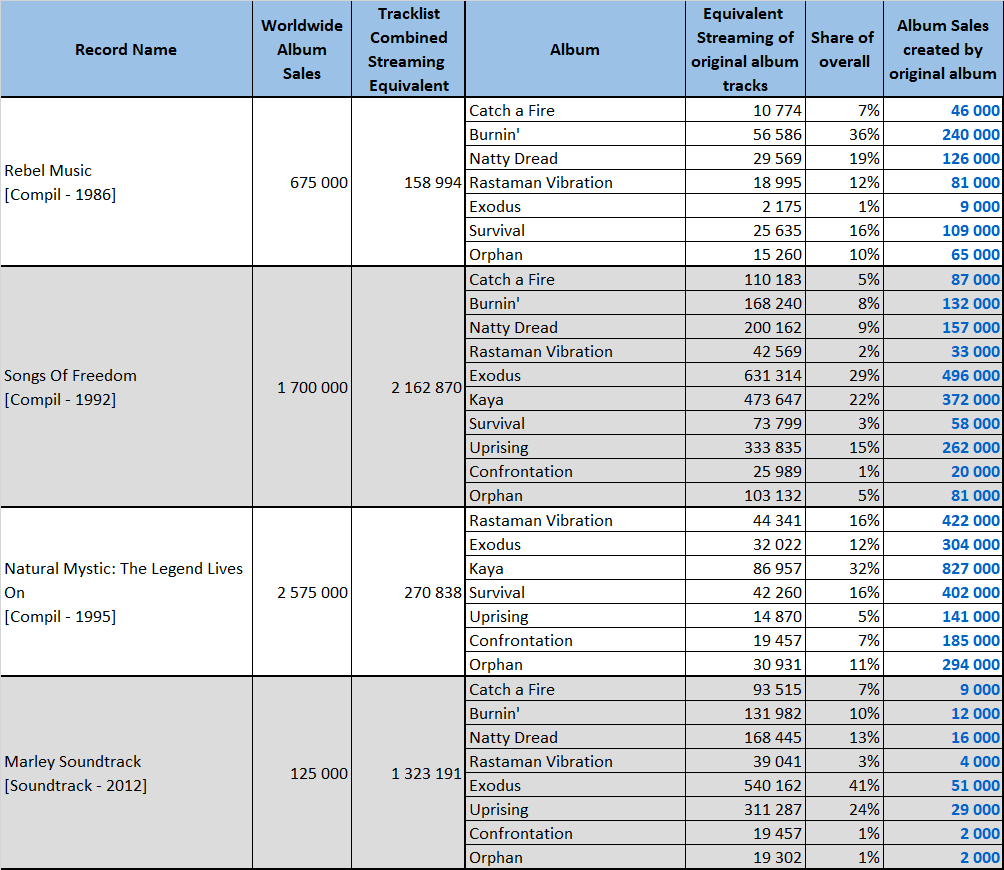
Part 5 – Major Live and Compilation albums
Among remix albums, Chant Down Babylon was especially successful. It is even more impressive when we consider that among the very top hits of Marley‘s catalog it features only Jamming.
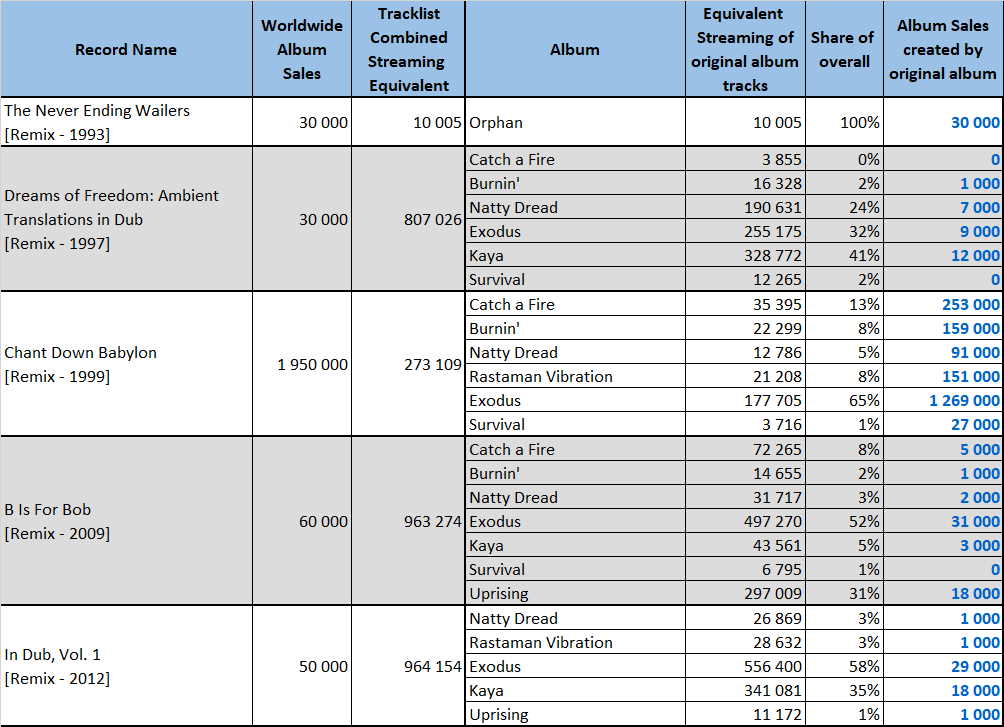
Part 6 – Music Videos
This list of music videos is divided into two kind of packages. Some are documentary-like releases, most notably The Bob Marley Story which are included into the Orphan category given they include no track list. Remaining videos are mostly live sets which include the big hits.
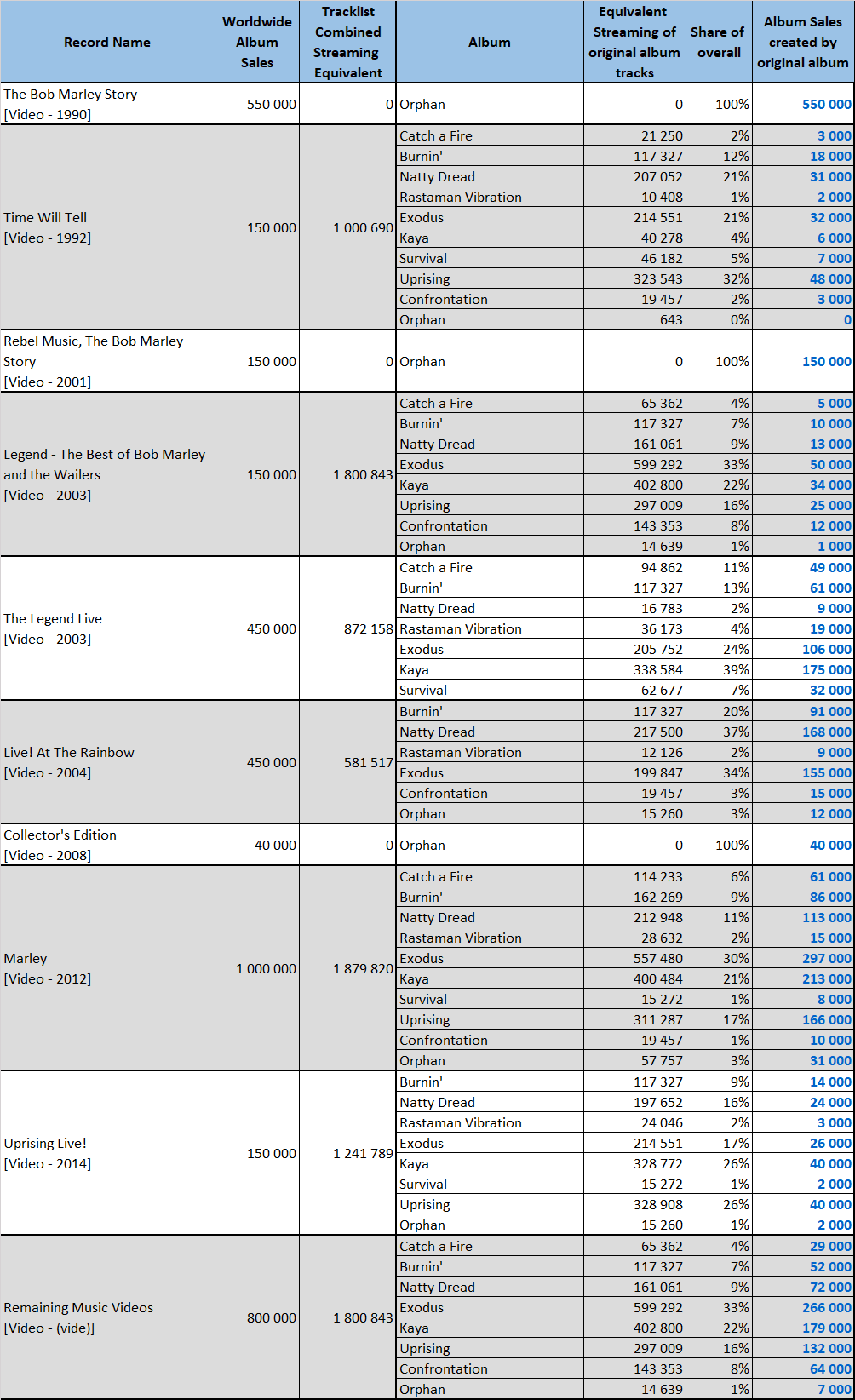
Part 7 – Early material compilations #1
Here comes the first batch of the countless albums that covered the 1963-1972 period of Marley‘s career. None of them really sold that much, which is natural as they weren’t promoted at all. They are mostly local albums issued by tiny labels that used the availability of those rights to drop an easy cash-in record. What’s absolutely impressive is the cumulative tally of those packages.
As those compilations involve very few high-profile songs, one wouldn’t bet they sold millions of units. Some tracks became popular afterwards though as part of albums like Catch a Fire and Burnin’. Added to the outstanding popularity of Marley this opened the door to tons of sales even for the most obscure compilations.
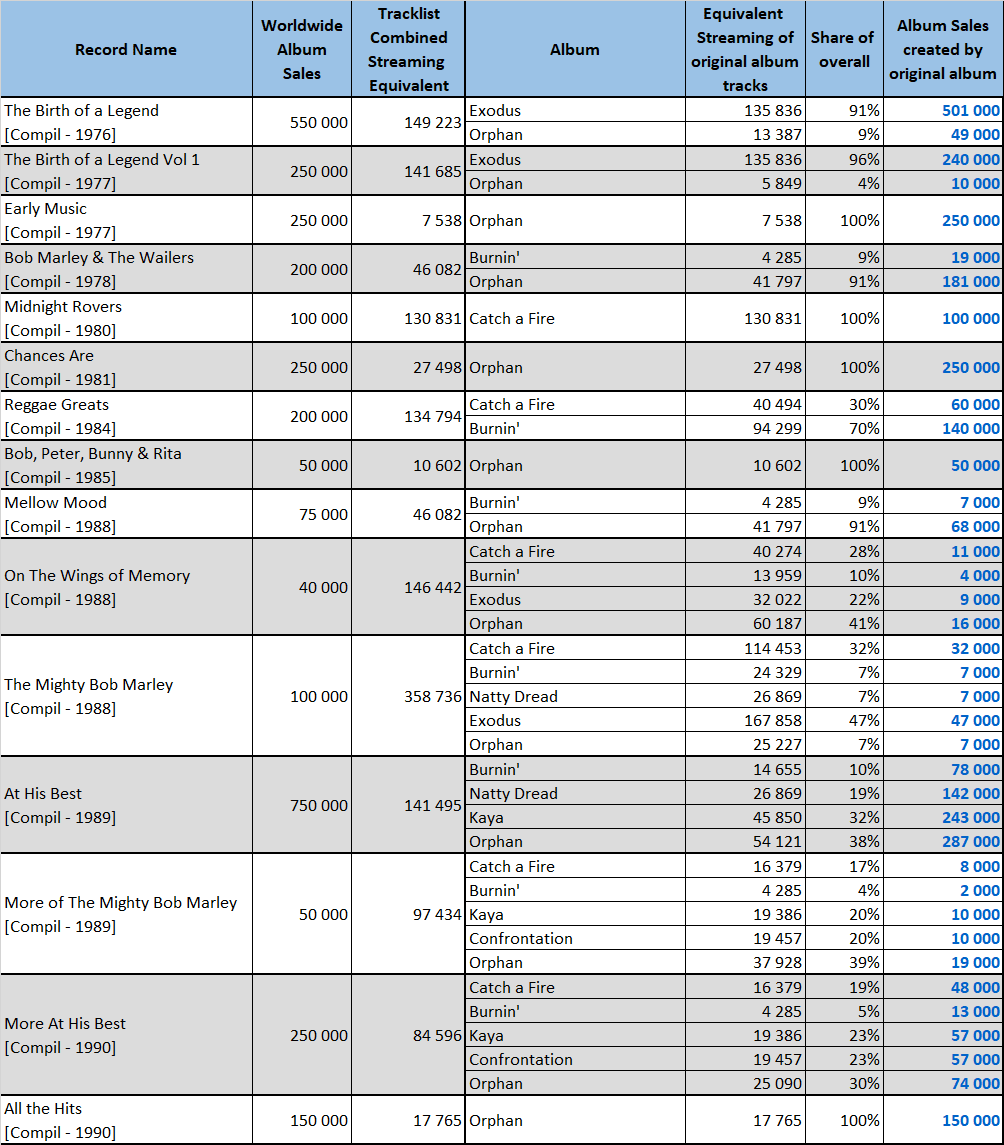
Part 8 – Early material compilations #2
The never ending flow of early material continues. More millions added to the bank.
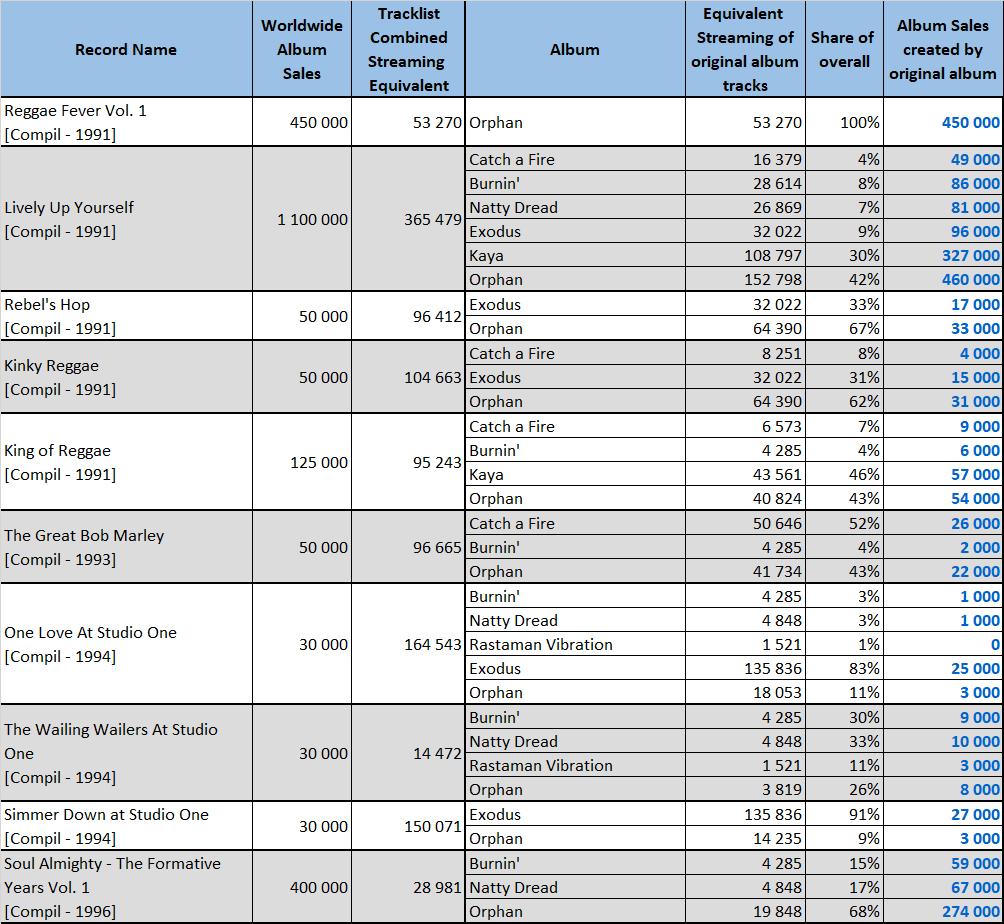
Part 9 – Early material compilations #3
Have I mentioned that those lists are only the visible part of the iceberg?
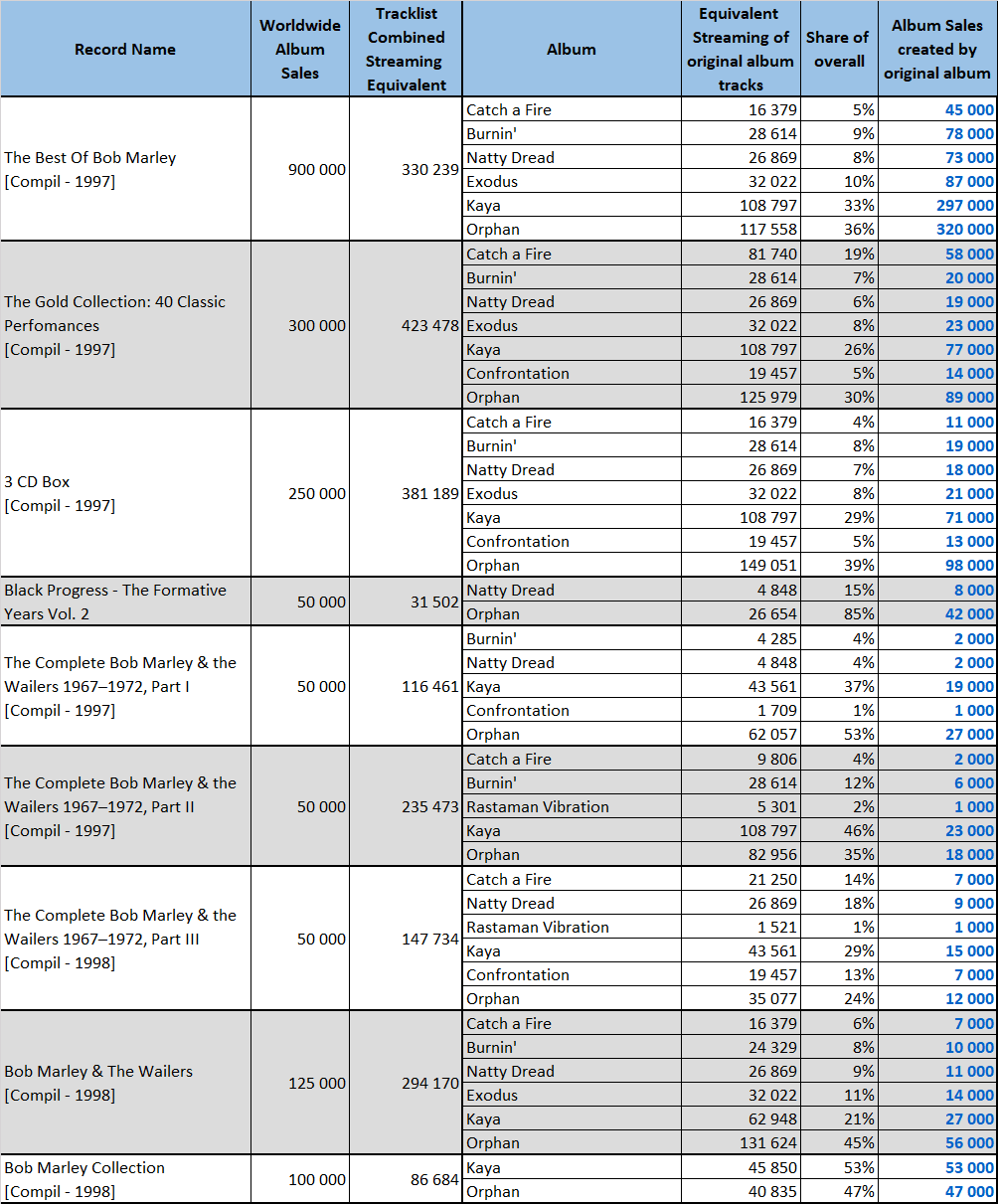
Part 10 – Early material compilations #4
The list isn’t over and we are already up to more than 7,6 million sales from those early material packages.
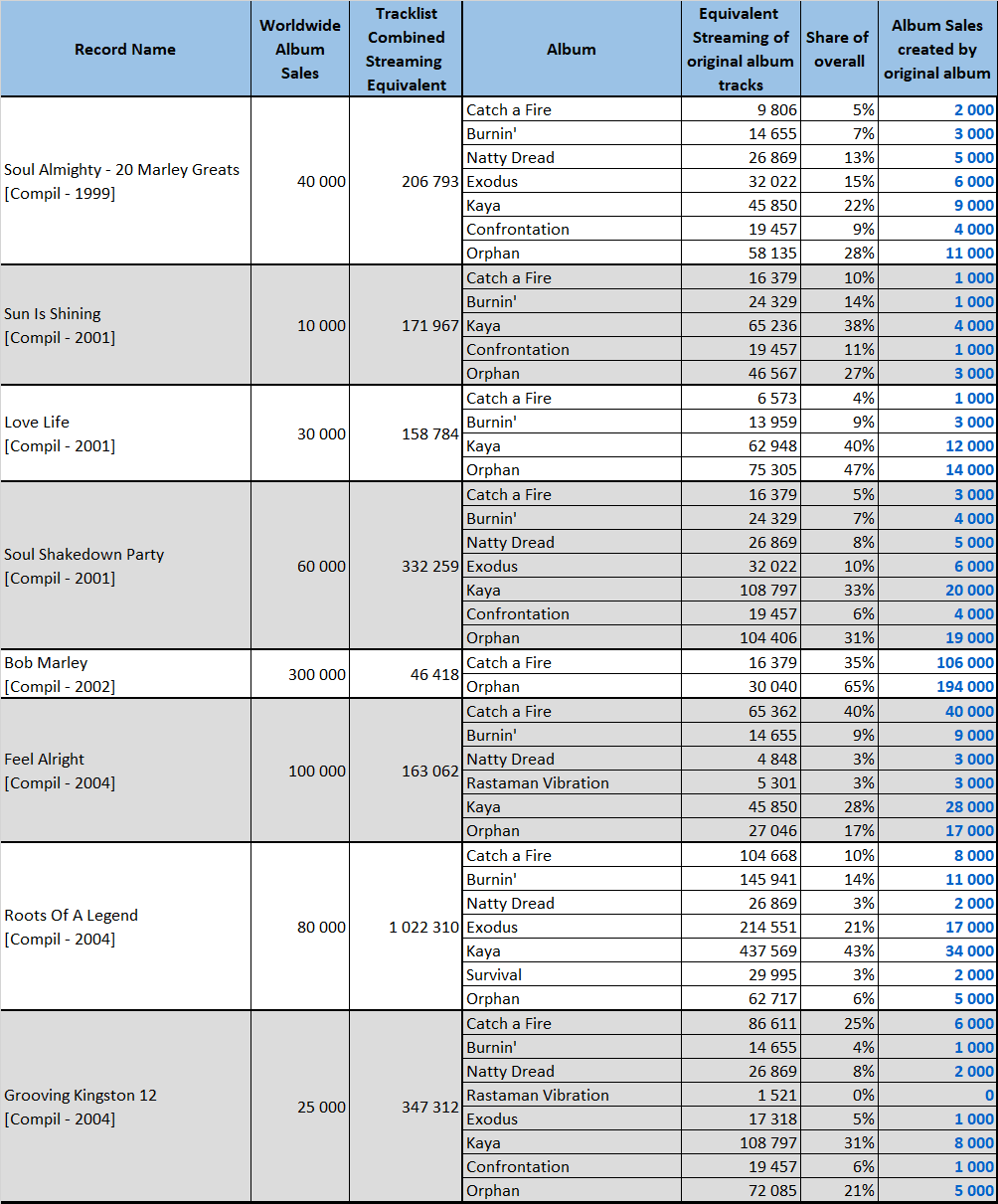
Part 11 – Early material compilations #5
Please notice the title of some of these budget releases. The Essential, The Best Of, All The Hits, At His Best, etc… While those early tunes include a lot of real gems, I feel the need to warn readers to make sure you are buying the tracks you want when going after a compilation of the reggae master.
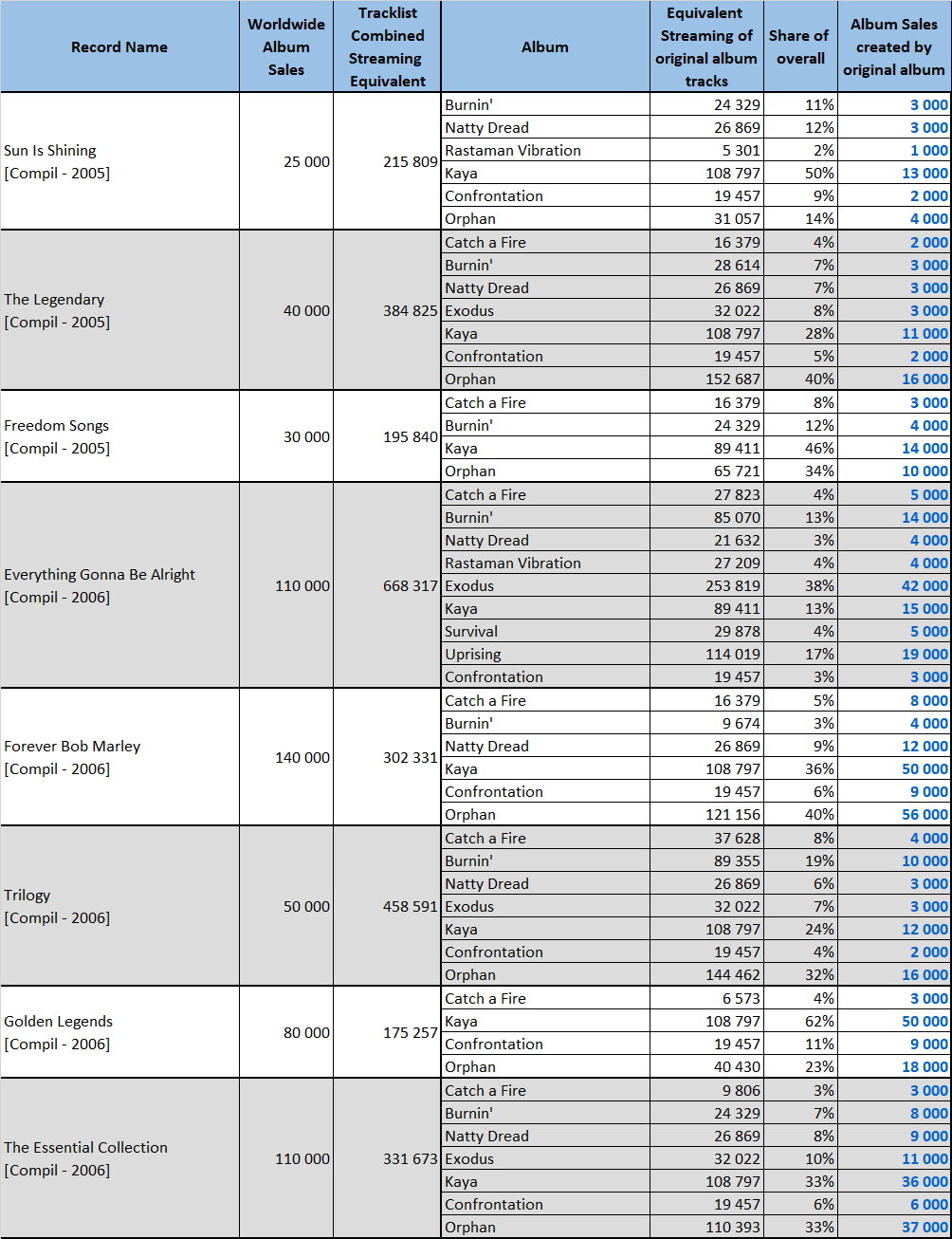
Part 12 – Early material compilations #6
We close this window related to the early songs with a Remaining Compilations line. We already identified tons of similar records, but there are still hundreds more, which leads me to add to this folder with 6,6 million sales.
In fact, when carefully looking at every US Soundscan sales (from 1991 to date) available for the 93 long format releases that are estimated on this study, we can point out a hole of more than 2 million sales between units moved from them and Marley‘s comprehensive total. This situation is repeated everywhere. It is due to the 700 plus compilations issued by an infinite number of labels.
A last element is 50 Greatest Songs. This set, released in some European nations, is a proper Island compilation, but it is included on this category because it isn’t available in the US nor in the UK.

Part 13 – Box sets
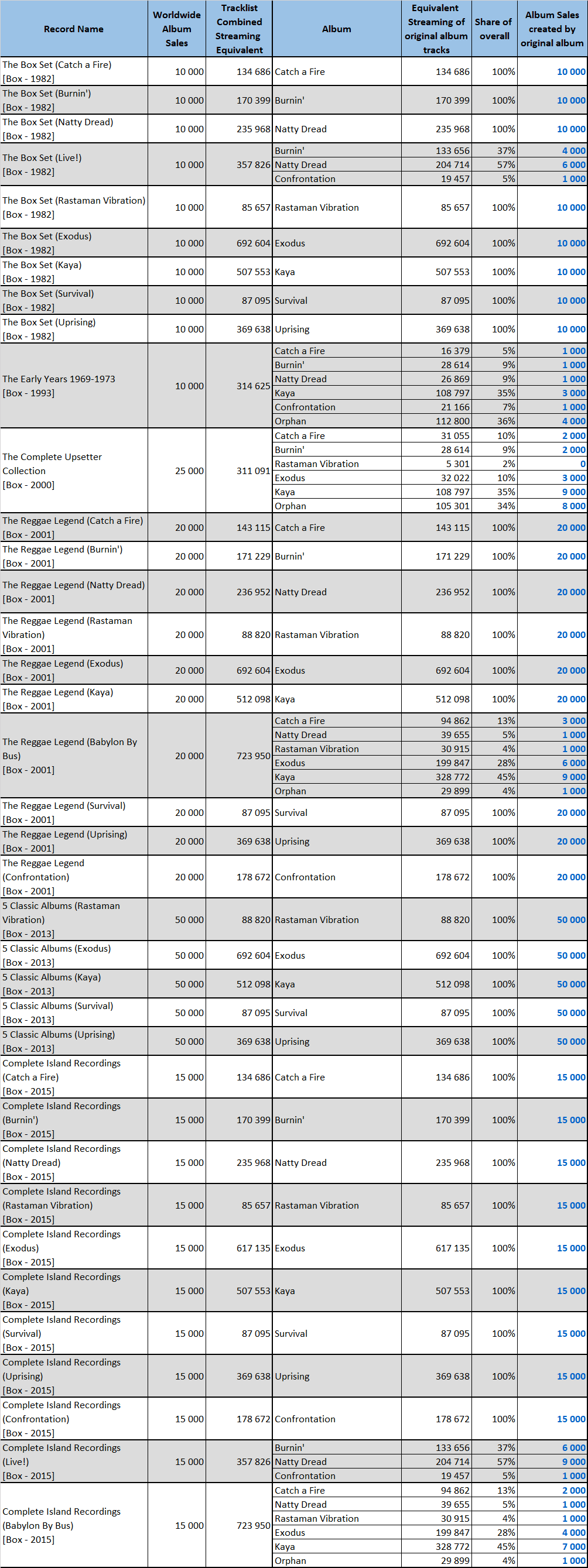
Full Length related records Sales – Summary
Here is the most underestimated indicator of an album’s success – the amount of compilation sales of all kinds it generated. Due to the dependency of sales of the original studio albums on these releases, they are a key piece of the jigsaw.
The reputation of Exodus seemed overrated considering its great but not record breaking sales. We already saw that its tracks sold plenty of units across multiple singles formats, now we can also see that they have been responsible for sales of more than 20 million compilations, a tremendous figure. The only reason why it hasn’t sold more units by itself is because of the heavy cannibalization it has suffered due to the release of various packages exploiting its songs.
Kaya is a close second at 17 million. We must point out that its figure is slightly inflated. The recent remixes of Is This Love give Kaya a bigger weight than it should organically have among Marley‘s catalog. Without the influx of those new remixes on streaming services, Kaya would have about 14 million sales from compilations rather than 17 million and the 3 million more sales would be distributed among the rest of his discography instead, led by Exodus.
Should we discredit all figures though? For several reasons, no. The boost received by Is This Love also boosted Legend, which increased its yearly sales in the UK from 91,000 units in 2015 to 172,000 in 2016 in the UK. That’s not quite a 3 million boost, even considering remaining markets. Still, Is This Love has been boosted today the same way that Three Little Birds was boosted by the movie I Am Legend, just like Jamming profile increased after a Vodafone commercial, etc. Each standard will get additional exposure here and there as it’s part of the life of a catalog. At the end of the day, the temporary boosts will get linearized by the ongoing streams of all songs and all figures will get back to their real organic level.
Kaya and Exodus aren’t the only worthy releases listed in this table. Burnin’, Natty Dread and Uprising are all responsible for a ridiculous amount of sales. Indeed, Marley‘s compilations, live, remix, and music videos packages sold a whopping 82 million units combined.

BONUS: Compilation Albums Sales
NB: N/A means no specific number is available. Sales from the country are still accounted for in the Worldwide estimate by using figure patterns of both the artist and the country market. Countries not displayed in this fixed panel are also factored in.
Live! (1975)
:format(jpeg):mode_rgb():quality(40)/discogs-images/R-663139-1208019254.jpeg.jpg)
- America
- US – 1,275,000
- Canada – 125,000
- Argentina – N/A
- Brazil – N/A
- Mexico – N/A
- Asia – N/A
- Japan – N/A
- Oceania
- Australia – 125,000
- New Zealand – 45,000
- Europe – 2,680,000
- UK – 300,000
- France – 505,000
- Germany – 450,000
- Italy – 425,000
- Spain – N/A
- Sweden – 60,000
- Netherlands – 160,000
- Switzerland – 50,000
- Austria – 50,000
- Finland – N/A
- World – 5,100,000
Babylon by Bus (1978)
:format(jpeg):mode_rgb():quality(40)/discogs-images/R-550028-1461070245-3432.jpeg.jpg)
- America
- US – 900,000
- Canada – 100,000
- Argentina – N/A
- Brazil – N/A
- Mexico – N/A
- Asia – N/A
- Japan – N/A
- Oceania
- Australia – 125,000
- New Zealand – 45,000
- Europe – 3,230,000
- UK – 250,000
- France – 680,000
- Germany – 600,000
- Italy – 425,000
- Spain – N/A
- Sweden – 75,000
- Netherlands – 200,000
- Switzerland – N/A
- Austria – N/A
- Finland – N/A
- World – 5,275,000
Legend (1984)
:format(jpeg):mode_rgb():quality(90)/discogs-images/R-1862222-1248530682.jpeg.jpg)
- America
- US – 16,775,000
- Canada – 1,750,000
- Argentina – 400,000
- Brazil – N/A
- Mexico – N/A
- Asia – N/A
- Japan – N/A
- Oceania
- Australia – 750,000
- New Zealand – 310,000
- Europe – 12,180,000
- UK – 3,935,000
- France – 1,920,000
- Germany – 1,525,000
- Italy – 925,000
- Spain – 400,000
- Sweden – 240,000
- Netherlands – 575,000
- Switzerland – 325,000
- Austria – 180,000
- Finland – 100,000
- World – 35,200,000
Natural Mystic: The Legend Lives On (1995)
:format(jpeg):mode_rgb():quality(40)/discogs-images/R-550373-1130366215.jpeg.jpg)
- America
- US – 900,000
- Canada – 125,000
- Argentina – 45,000
- Brazil – N/A
- Mexico – N/A
- Asia – N/A
- Japan – N/A
- Oceania
- Australia – 25,000
- New Zealand – 35,000
- Europe – 1,130,000
- UK – 175,000
- France – 270,000
- Germany – 160,000
- Italy – 75,000
- Spain – 100,000
- Sweden – 25,000
- Netherlands – 50,000
- Switzerland – 35,000
- Austria – 5,000
- Finland – N/A
- World – 2,575,000
One Love: The Very Best of (2001)
- America
- US – 625,000
- Canada – 125,000
- Argentina – 100,000
- Brazil – 60,000
- Mexico – N/A
- Asia – N/A
- Japan – N/A
- Oceania
- Australia – 70,000
- New Zealand – 25,000
- Europe – 1,760,000
- UK – 325,000
- France – 250,000
- Germany – 225,000
- Italy – 225,000
- Spain – 150,000
- Sweden – 50,000
- Netherlands – 90,000
- Switzerland – 40,000
- Austria – 45,000
- Finland – N/A
- World – 3,300,000
BONUS: Total Album (all types) Sales per Country
- America
- US – 41,935,000
- Canada – 4,790,000
- Argentina – N/A
- Brazil – N/A
- Mexico – N/A
- Asia – N/A
- Japan – N/A
- Oceania
- Australia – 2,485,000
- New Zealand – 1,075,000
- Europe – 51,810,000
- UK – 9,880,000
- France – 10,960,000
- Germany – 7,790,000
- Italy – 5,020,000
- Spain – 2,350,000
- Sweden – 1,150,000
- Netherland – 2,205,000
- Switzerland – 1,235,000
- Austria – 805,000
- Finland – 380,000
- World – 120,150,000
Please note that some of the countries totals may be slightly incomplete when the figure is N/A for minor releases. Countries with too much missing information to be precise enough are listed as N/A. In the meantime, the rough estimate of his sales in Latin America is calculated at more than 8 million units while Asian sales account for less than 6 million sales.
Bob Marley Career CSPC Results
So, after checking all the figures, how many overall equivalent album sales has each album by Bob Marley achieved? Well, at this point we hardly need to add up all of the figures defined in this article!
In the following results table, all categories display figures in equivalent album sales. If different, pure sales are listed between parentheses.
As a reminder:
- Studio Album: sales of the original album
- Other Releases: sales of compilations generated thanks to the album
- Physical Singles: sales of physical singles from the album (ratio 3/10)
- Download Singles: sales of digital singles from the album (ratio 1,5/10)
- Streaming: equivalent album sales of all the album tracks (ratio 1/1500 for Audio stream and 1/6750 for Video stream)
Artist career totals
See where the artist ranks among remaining singers
The icon of a generation, the king of reggae, the face of Jamaica, the legendary singer, the symbol of peace, the flagship of rastas, the defender of the oppressed people, the genius writer, the God of lost minds, the voice of Africa. Marley has been described by more roles than Daenerys Targaryen and his hair is just as known as hers. Although his strength as a super records seller is rarely mentioned, figures don’t lie, so you can add massively successful star to his résumé.
Ultimately, there aren’t that many Rastafarians, even among people who proudly wear dreadlocks. The message of Marley wasn’t his religion though. He wrote his music to support the people who need it the most, to share positive feelings. To denounce abuses and call for respect of every human being. The general public understood it.
Decades after his death it is thus no surprise to see his catalog going stronger than ever. His popularity goes much further than the reggae spectrum, he belongs to the all-time greats. His audio streams are almost on par with acts like Queen and Michael Jackson who are among the leaders in that format. This shows how insanely popular he is also among the youngest public.
Exodus is the best example of this flamboyant appeal. The album is up to a stunning 31,5 million equivalent album sales overall to put it among the very most successful albums of all-time. Kaya is close to 25 million. Uprising comes third among his albums at 16 million. His entire discography is impressive with Burnin’ and Natty Dread topping 10 million with ease too.
Rastaman Vibration and Survival are the lowest albums in spite of a truly solid 6 million sales each. The posthumous Confrontation has a surprising total of 8 million, but this still falls short of the near incredible 11 million sales of Orphan products. There is nothing to throw away.
Born in Nine Mile, a tiny Jamaican village of 300 inhabitants, and having grown up in Trenchtown slums, Marley climbed the ladder to become a global icon, his total of 135,5 million equivalent album sales certainly confirms that. Undoubtedly, his impact among the World cultural heritage goes beyond the numbers.
The following sections list his most successful songs as well as his records and achievements.
As usual, feel free to comment and / or ask a question!
Sources: IFPI, Spotify, YouTube, Chartmasters.org.
Bonuses
BIGGEST TRACKS – Bob Marley
The list of most successful songs is compiled in album equivalent sales generated by each of them. It includes the song’s own physical singles sales with a 0,3 weighting, its download and streaming sales, and with appropriate weighting too, plus its share among sales of all albums on which it is featured.
1 1978 – Is This Love [Kaya] – 15,470,000
2 1974 – No Woman, No Cry [Natty Dread] – 9,770,000
3 1980 – Could You Be Loved [Uprising] – 8,870,000
4 1977 – Three Little Birds [Exodus] – 8,820,000
5 1977 – Jamming [Exodus] – 7,900,000
6 1977 – One Love / People Get Ready [Exodus] – 6,880,000
7 1983 – Buffalo Soldier [Confrontation] – 6,320,000
8 1980 – Redemption Song [Uprising] – 5,350,000
9 1973 – Get Up, Stand Up [Burnin’] – 4,120,000
9 1973 – I Shot the Sheriff [Burnin’] – 4,120,000
11 1973 – Stir It Up [Catch a Fire] – 4,050,000
12 1978 – Satisfy My Soul (aka Don’t Rock My Boat) [Kaya] – 3,150,000
13 1978 – Sun Is Shining [Kaya] – 3,110,000
14 1977 – Waiting in Vain [Exodus] – 2,380,000
15 1974 – Lively Up Yourself [Natty Dread] – 2,220,000
16 1977 – Exodus [Exodus] – 2,200,000
17 1977 – Natural Mystic [Exodus] – 1,760,000
18 1976 – Positive Vibration [Rastaman Vibration] – 1,570,000
19 1978 – Easy Skanking [Kaya] – 1,400,000
20 1982 – Trench Town [Confrontation] – 1,380,000
21 1976 – Roots, Rock, Reggae [Rastaman Vibration] – 1,310,000
22 1973 – Concrete Jungle [Catch a Fire] – 1,050,000
23 1979 – One Drop [Survival] – 1,040,000
24 1979 – Africa Unite [Survival] – 1,030,000
25 1970 – Soul Rebel (aka Run for Cover) [Orphan] – 1,010,000
Records & Achievements
- At 135,46 million equivalent album sales, Bob Marley is the most successful Caribbean act of all-time. He is also the most successful reggae artist ever.
- At 11,09 million equivalent album sales, Burnin’ is one of the 20 most successful albums from 1973.
- At 13,65 million equivalent album sales, Natty Dread is the 3rd most successful album from 1974.
- At 31,50 million equivalent album sales, Exodus is the 4th most successful album from 1977.
- At 24,79 million equivalent album sales, Kaya is the 3rd most successful album from 1978.
- At 16,02 million equivalent album sales, Uprising is one of the 10 most successful albums from 1980.
- At 9,77 million equivalent album sales, No Woman No Cry is the second most successful song from 1974.
- At 1,934,000 equivalent album sales from streams, Bob Marley‘s 70s catalog is the most streamed artist-catalog of the decade.
- At 283 million streams at Spotify, Is This Love is the 2nd most streamed song from the 70s.
- At 188 million streams at Spotify, Three Little Birds is one of the 10 most streamed songs from the 70s.
- At 35,2 million Worldwide sales, Legend is the second best selling compilation of all-time.
- At 12,45 million Soundscan sales, Legend is the greatest selling catalog of the Soundscan era (1991-2017) in the US.
- With more than 30 years, Legend owns the slowest climb to the Top 10 of the US BB200 chart.
- Legend is the greatest selling album ever which contains no Billboard Hot 100 hit.
We have more for you…
… a special focus on Bob Marley‘s success in France
… checking out the upcoming artists or even voting for them!
… best-selling artists, albums, and singles
This article is being discussed in our forum, join us to share your comments! »















